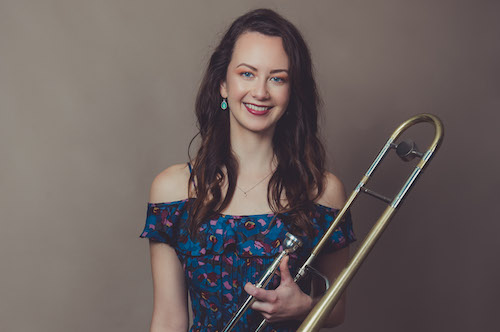Jun 3, 2025 11:25 AM
In Memoriam: Al Foster, 1943–2025
Al Foster, a drummer regarded for his fluency across the bebop, post-bop and funk/fusion lineages of jazz, died May 28…

Trombonist and singer Natalie Cressman, a San Francisco native, currently is based in New York.
(Photo: Lauren Desberg)Natalie Cressman’s career is soaring due to her artistic flexibility. At 28, the vocalist and winner of the category Rising Star–Trombone has collaborated with numerous individualists, including jazz trumpeter Nicholas Payton and Phish guitarist/vocalist Trey Anastasio.
Playing in a range of contexts has influenced her views on musical inclusion and expansion. “By being myself in every genre—trying to play the style but also following the aesthetic that I enjoy and the tone that I like on the trombone—I’ve found my niche,” she said.
Her 2019 duo release with guitarist/composer Ian Faquini, Setting Rays Of Summer (Cressman Music), explores a Brazilian aesthetic. “I’ve always loved that marriage between groove music and harmonic depth,” she explained.
As a singer, Cressman has developed a unique relationship with her horn. “So much of what I love is the great storytelling and expression that comes with the human voice,” she said. “So, when I play trombone, I try to stay in that mode and not get too caught up in filling the space with too many notes—really trying to be lyrical and melodic.”
Faquini is drawn to Cressman’s sound, intention and collaborative attitude.
“She has the most beautiful trombone sound,” said Faquini, who composed the music for Setting Rays. “It doesn’t sound like that stereotypical, super-loud brass section trombone sound. It’s more like a beautiful voice—a very clean, clear tone. But that’s just the technique. [She also has] amazing note selection and ideas. She really sings with it, more than [playing] horn riffs.”
As an improviser, Cressman found herself digging deep to get inside Faquini’s harmony. “Generally, the functionality of the harmony is similar to jazz, but his harmonic sense draws from a lot of classical impressionist composers,” she said. “He’s a protégé of Guinga, who has a very rich sense of harmony—a lot of different extensions and unexpected roots. There’s so much to grab on to as an improviser.”
Compelled to create, stretch and push, Cressman admitted that it took some time to figure out where her sound truly resonates. “I’ve never really found my home in just straightahead music, because I don’t feel like there’s room for me to innovate that,” she said. “I love playing that kind of music, but for me, original music that takes pieces from many different sources is way more inspiring.”
Her parents—vocalist Sandy Cressman and trombonist Jeff Cressman—undoubtedly shaped Cressman’s interest in a wide variety of music. And with that legacy comes critical awareness; Cressman moved to New York as a way of mapping her own route through the music.
“I wanted to be judged on my own merits,” said Cressman, a native of San Francisco. “I didn’t want to just get a leg up by being Sandy and Jeff’s daughter in the Bay Area. They provided me many great opportunities, but I really wanted the chance to develop into my own person as a musician.”
Despite their apparent differences, Cressman views each new project she engages as similar. “Musicians I’ve played with, even in a more ‘commercial setting,’ they’re [artists] who have found their own way and become massively successful in providing the unexpected,” she said. Anastasio saw a spark of innovation in Cressman the moment he heard her play as a first-year student at Manhattan School of Music.
“Even at that young age, she already had so many crucial elements of her musicianship fully in place—a warm and musical tone, enormous confidence and a huge range,” said Anastasio, who, in addition to performing with Phish also leads the Trey Anastasio Band.
“She could play fast, clean runs in the low range without blinking an eye, and sight-read literally any chart that I put in front of her.” Regarding the TAB’s complex charts, Anastasio quipped, “Natalie eats them for breakfast.”
During a recent concert in New Orleans, Cressman unleashed certain ideas she’d been exploring for the past few years, and left the bandstand feeling a sense of power.
“I felt like I had new options,” she said. “I felt this confidence to shape it and break it open and make it something different.” DB

Foster was truly a drummer to the stars, including Miles Davis, Sonny Rollins and Joe Henderson.
Jun 3, 2025 11:25 AM
Al Foster, a drummer regarded for his fluency across the bebop, post-bop and funk/fusion lineages of jazz, died May 28…

“Branford’s playing has steadily improved,” says younger brother Wynton Marsalis. “He’s just gotten more and more serious.”
May 20, 2025 11:58 AM
Branford Marsalis was on the road again. Coffee cup in hand, the saxophonist — sporting a gray hoodie and a look of…

“What did I want more of when I was this age?” Sasha Berliner asks when she’s in her teaching mode.
May 13, 2025 12:39 PM
Part of the jazz vibraphone conversation since her late teens, Sasha Berliner has long come across as a fully formed…

Roscoe Mitchell will receive a Lifetime Achievement award at this year’s Vision Festival.
May 27, 2025 6:21 PM
Arts for Art has announced the full lineup for the 2025 Vision Festival, which will run June 2–7 at Roulette…

Benny Benack III and his quartet took the Midwest Jazz Collective’s route for a test run this spring.
Jun 3, 2025 10:31 AM
The time and labor required to tour is, for many musicians, daunting at best and prohibitive at worst. It’s hardly…